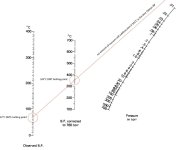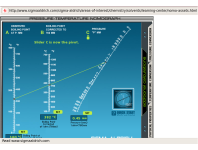spaghettiman
Rising Star
I have done some searching recently, and have been surprised to find
that there seems to be no decent source stating the boiling points of
the freebase forms of some alkaloids of interest:
DMT
5-MeO-DMT
Gramine
Now, the merck index states that DMT has a BP of 60-80C, this is clearly
incorrect. Not at ambient pressures.... this information needs to be
filled in. Shulgun should have measured it for us damnit! he states that
this value is incorrect himself!(TiHKAL)
gramine HCl decomposes at 191C (merck)
gramine freebase melts at ~138(merck) so we know it boils higher than
that. probably much higher
bufotenin has a BP of 320C(merck)
5-MeO-DMT I have not done enough research on, but the BP at atmospheric
pressure seems unavailable, though should be high. here is what i have:
This is very low pressure. Though, i believe the eroneous values for DMT are from this mixup, 60-80C is correct at very low pressure, a few mm/Hg.
Now, does anyone have any information that can fill any of these gaps?
am i crazy? How the hell has no one measured the BP of DMT at atm?!?!?!?! why
do people still cite the merck value?!
lets make a table of these values, or our best guesses. we want the freebases for use for future sublimation teks for phalaris and other dirty sources.
This subject needs attention... We need a better grasp on these basic properties.
I think DMT vapes around 170-200C at normal atmousphereic pressures. I have no quantitative evidence of this at this time. discuss...
that there seems to be no decent source stating the boiling points of
the freebase forms of some alkaloids of interest:
DMT
5-MeO-DMT
Gramine
Now, the merck index states that DMT has a BP of 60-80C, this is clearly
incorrect. Not at ambient pressures.... this information needs to be
filled in. Shulgun should have measured it for us damnit! he states that
this value is incorrect himself!(TiHKAL)
gramine HCl decomposes at 191C (merck)
gramine freebase melts at ~138(merck) so we know it boils higher than
that. probably much higher
bufotenin has a BP of 320C(merck)
5-MeO-DMT I have not done enough research on, but the BP at atmospheric
pressure seems unavailable, though should be high. here is what i have:
(TiHKAL)The residue was distilled at the KugelRohr to provide a colorless fraction distilling at 160–170 °C at 0.6 mm/Hg, that crystallized on cooling.There was thus obtained 12.8 g (78%) 5-methoxy-N,N-dimethyltryptamine (5-MeO-DMT) which on recrystallization from hexane had a mp 69–70 °C.
This is very low pressure. Though, i believe the eroneous values for DMT are from this mixup, 60-80C is correct at very low pressure, a few mm/Hg.
Now, does anyone have any information that can fill any of these gaps?
am i crazy? How the hell has no one measured the BP of DMT at atm?!?!?!?! why
do people still cite the merck value?!
lets make a table of these values, or our best guesses. we want the freebases for use for future sublimation teks for phalaris and other dirty sources.
This subject needs attention... We need a better grasp on these basic properties.
I think DMT vapes around 170-200C at normal atmousphereic pressures. I have no quantitative evidence of this at this time. discuss...




